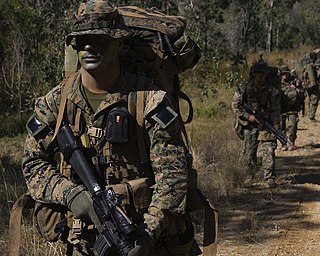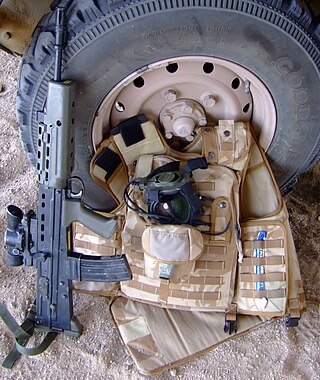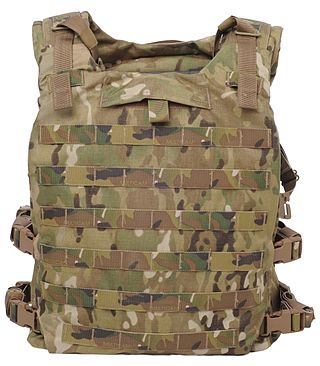Notes
Related Research Articles
The Interceptor Multi-Threat Body Armor System (IBA) is a bullet-resistant body armor system that was used by the United States Armed Forces during the 2000s, with some limited usage into the mid-2010s. IBA and its design replaced the older standardized fragmentation protective Personnel Armor System for Ground Troops (PASGT) body armor system that was designed in the late 1970s and introduced in the early 1980s.

MOLLE is an acronym for Modular Lightweight Load-carrying Equipment. It is used to define the current generation of load-bearing equipment and backpacks used by a number of NATO armed forces, especially the British Army and the United States Army.

Personnel Armor System for Ground Troops is a combat helmet and ballistic vest that was used by the United States military from the early 1980s until the mid-2000s, when the helmet and vest were succeeded by the Lightweight Helmet (LWH), Modular Integrated Communications Helmet (MICH), and Interceptor Body Armor (IBA) respectively.

The United States Marine Corps Reconnaissance Battalions are the special operations reconnaissance assets of Marine Air-Ground Task Force that provide division-level ground and amphibious reconnaissance to the Ground Combat Element within the United States Marine Corps. Division reconnaissance teams are employed to observe and report on enemy activity and other information of military significance in close operations. The Military Occupational Specialty code for Reconnaissance Marine is 0321.

The Modular Integrated Communications Helmet (MICH) is a U.S. combat helmet and one of several used by the U.S. military. It was developed by the United States Army Soldier Systems Center to be the next generation of protective combat helmets for use by the U.S. Army.

The IIFS was introduced in 1988, to serve as a fighting and existence carrying system—a possible replacement for the All-purpose Lightweight Individual Carrying Equipment employed and fielded by United States Armed Forces since 1973.

The Improved Load Bearing Equipment (ILBE) is a United States Marine Corps program that had included individual load carriage equipment, individual hydration systems and individual water purification.

The Modular Tactical Vest is a ballistic vest originally adopted by the United States Marine Corps in 2006. The MTV was designed as a solution to shortcomings in the Interceptor Body Armor (IBA) and was selected after a rigorous proposal and examination process by the Marine Corps. The MTV provides better protection levels than the IBA, although it uses the same Small Arms Protective Insert (SAPI) plates. The MTV weighs 30 pounds (14 kg), three pounds more than the IBA, but is designed to more effectively distribute its weight throughout the wearer's torso.

CIRAS is a modular protective vest designed for US Special Operations Forces by Eagle Industries. The vest is currently the new FSBE II system and has replaced the FSBE AAVs. It features PALS webbing, making it MOLLE-compatible and allowing the attachment of various pouches or accessories. Two versions of the vest are available, known as the "land" and "maritime" versions. The vest consists of front and rear panels with pockets for BALCS or SPEAR-cut soft armor panels and standard-issue SAPI plates. This gives the wearer up to NIJ Level IV protection on the front and back and Level IIIA protection on the sides. On the lower rear side of the front of the vest, there are two quick-releasable buckles for attaching groin protection. The wearer's sides are covered by an external cummerbund, which is also covered with PALS webbing. The vest body is constructed of 1000-denier Cordura Nylon, and the interior is lined with heavy-duty mesh to aid in cooling the wearer.

Osprey body armour is a system of body armour used by the British Armed Forces. The system is in its fourth iteration following extensive development and engagement with front line users.

The Improved Outer Tactical Vest (IOTV) is an enhanced version of, and a replacement for, the older Outer Tactical Vest (OTV) variant of the Interceptor Multi-Threat Body Armor System, as fielded by the United States Army. The IOTV is compatible with the Deltoid and Axillary Protector System (DAPS) components, ESAPI, Enhanced Side Ballistic Inserts (ESBI), as well as the OTV's groin protector. It has a flame-resistant standalone shirt, the Army Combat Shirt, designed specifically for use with the IOTV.

The Pouch Attachment Ladder System or PALS is a grid of webbing invented and patented by United States Army Natick Soldier Research, Development and Engineering Center used to attach smaller equipment onto load-bearing platforms, such as vests and backpacks. It was first used on MOLLE rucksacks, but is now found on a variety of tactical equipment, such as the U.S. Improved Outer Tactical Vest, Interceptor body armor, USMC Improved Load Bearing Equipment backpack and Modular Tactical Vest. It is used to attach items such as holsters, magazine pouches, radio pouches, knife sheathes, and other gear. A wide variety of pouches are commercially available, allowing soldiers to customize their kit. There is also a variety of attachment methods including the Alice Clip, the Natick snap, and soft, interwoven straps. The PALS system has begun to be adopted by other forces, such as the British Army, who use it on their Osprey body armor.

Tactical Vest Antenna System (TVAS) is a type of wearable antenna designed for use by the United States Armed Forces. It is claimed that troops equipped with the TVAS are more effective than traditional whip antenna-equipped troops due to better concealment of the equipment and mobility improvement to the operator. TVAS was developed by Wearable Antenna Technologies Inc. in early 2008.
Air Warrior (AW) is a modular, integrated, rapidly reconfigurable combat aircrew ensemble designed for U.S. Army aircrews. Previous aviation life support equipment consisted of a non-integrated assemblage of protective and survival gear. AW uses a systems approach to equipping the aircrew and closes the capability gap between human and machine. Fielded incrementally in blocks to rapidly provide enhanced capabilities to the warfighter, AW leverages and integrates clothing and equipment, such as the Army Aircrew Combat Uniform and ballistic protection, from other product managers. As of April 2010, more than 18,000 AW systems had been fielded in support of Operation Iraqi Freedom and Operation Enduring Freedom.

The Soldier Plate Carrier System (SPCS), known commercially as the KDH Magnum TAC-1, is a plate carrier developed for the U.S. Army which provides protection in accordance with if not greater than, the Improved Outer Tactical Vest. The SPCS is a lighter alternative to the IOTV, with increased mobility and comfort. The MSV, part of the US Army's SPS, is intended to replace all currently fielded body armor systems.
The Modular Body Armor Vest (MBAV) is a bullet-proof vest made by Eagle Industries and used by the United States military. The vest is standard issue for many members of the United States special operations forces including the 75th Ranger Regiment. 10,000 vests were deployed on an interim basis with the U.S. Marine Corps while it developed the Scalable Plate Carrier. The vest was also evaluated by the U.S. Army.
Family of Improved Load Bearing Equipment (FILBE) is a series of equipment used by the United States Marine Corps for personal load carrying. It comprises the backpack and various attachments carried by an individual Marine in the field. The FILBE was designed as an improvement over the prior ILBE system that was not compatible with the newest body armor systems.

Ratnik is a Russian future infantry combat system. Some components, including the communication systems and night vision technologies, have extremely limited military distribution. It is designed to improve the connectivity and combat effectiveness of combat personnel in the Russian Armed Forces. Improvements include modernised body armour, a helmet with a special eye monitor, communication systems, and special headphones. It includes 10 subsystems and 59 individual items.
References
- ↑ "First remains of Marine helicopter crash victims recovered". 1999-12-19. Archived from the original on 2008-05-27. Retrieved 2008-10-10.
- ↑ "December 1999, Summary of news for the entire month". 2000-12-01. Archived from the original on May 15, 2008. Retrieved 2008-10-10.
- ↑ Rogers, Patrick A. "Strong Men Armed". The Accurate Rifle. 4 (3). Retrieved 2008-11-16.